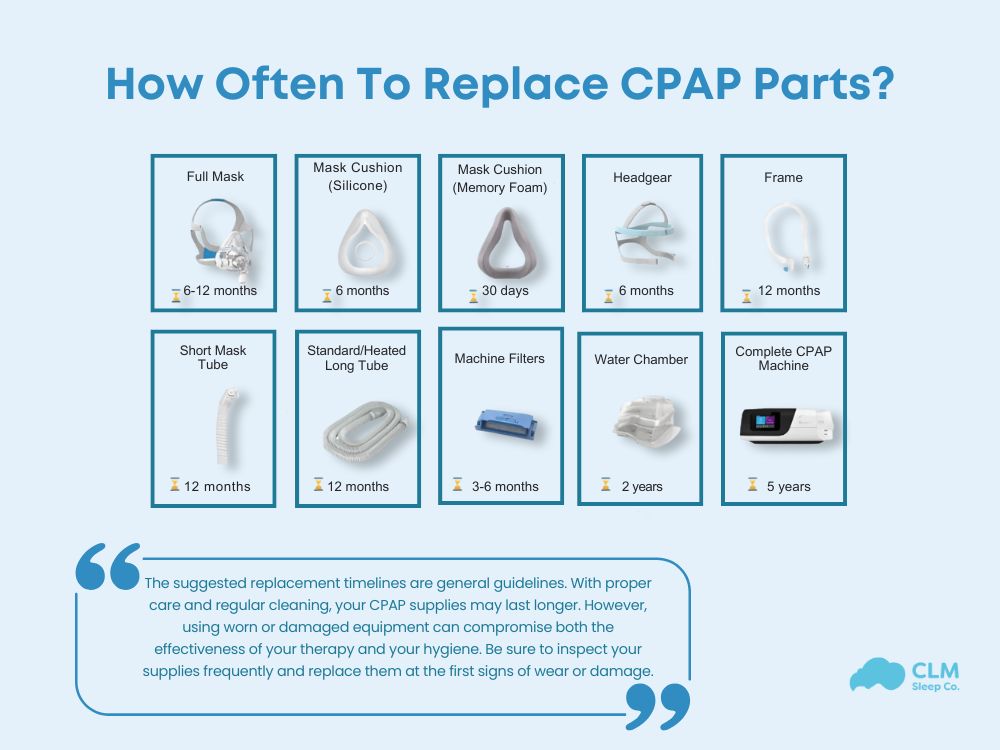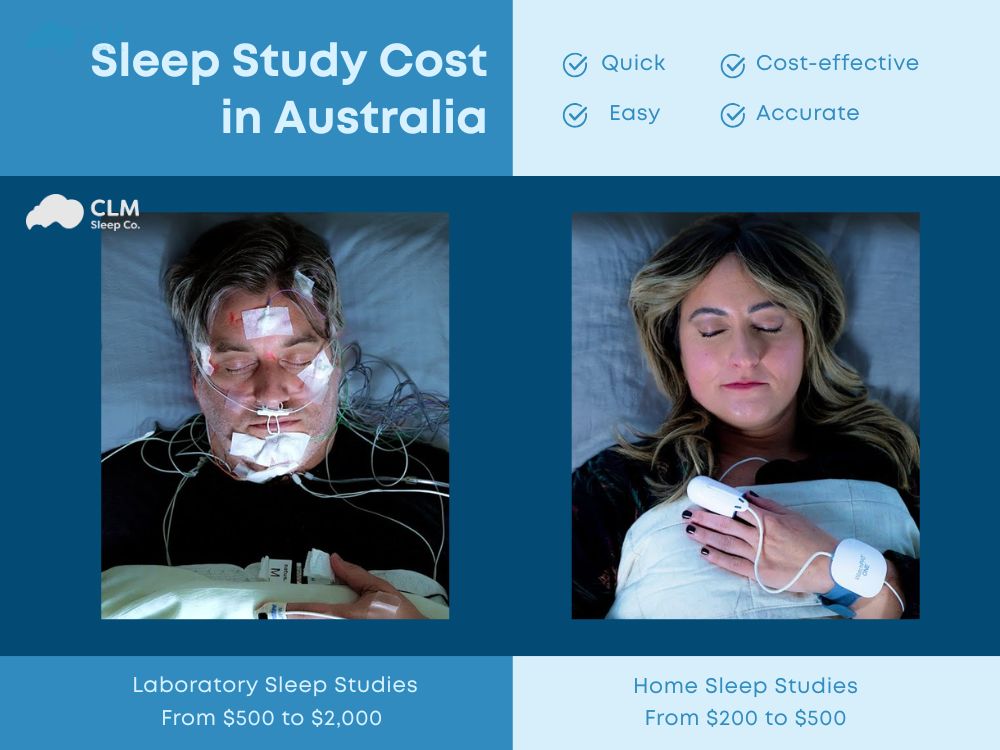Using a CPAP (Continuous Positive Airway Pressure) machine is a vital step in treating obstructive sleep apnea, but proper maintenance is just as essential. One key overlooked aspect is knowing when to replace essential parts like masks, filters, and tubing. These components wear down over time due to regular use, moisture, and skin oils, leading to leaks, discomfort, reduced effectiveness, and potential health risks. In this CLM Sleep guide, we’ll cover how often to replace each CPAP part, signs of wear to watch for, and how regular replacements can help you stay on track with your therapy.
Overview
Continuous Positive Airway Pressure (CPAP) therapy is widely recognized as the most effective treatment for obstructive sleep apnea (OSA), significantly improving sleep quality, reducing daytime fatigue, and lowering the risk of cardiovascular complications. However, the effectiveness of CPAP therapy depends heavily on the proper maintenance and timely replacement of its components. Over time, CPAP parts are subject to wear and tear, accumulation of facial oils, and exposure to moisture, all of which can reduce their performance and hygiene.
Knowing when to replace your CPAP equipment helps ensure consistent therapy results, minimizes the risk of infection, and enhances user comfort.
Why is replacing CPAP parts regularly important?
Regular maintenance of your CPAP equipment isn’t just about keeping things clean, it directly impacts the effectiveness of your therapy, your comfort, and the longevity of your machine. Here are the key reasons why timely replacement of CPAP parts is essential:
Maintain optimum performance
Over time, CPAP components degrade, which can cause air leaks or inconsistent pressure delivery. These issues can result in reduced therapeutic benefits, frequent awakenings, and even non-compliance with treatment. Ensuring parts are replaced on schedule helps maintain the correct air pressure and optimal machine functionality.
Ensure a comfortable user experience
Comfort is critical to CPAP therapy adherence. Worn-out masks and stretched-out headgear may cause discomfort, skin irritation, or even pressure sores. Fresh components help create a better fit, reducing facial marks and enhancing the likelihood of long-term compliance.
Promote hygiene and cleanliness
CPAP equipment is in constant contact with your face and respiratory system. Over time, moisture and oils create a breeding ground for bacteria, mold, and allergens. Regular replacement reduces the risk of infections and allergic reactions, especially in individuals with compromised immune systems.
Extend the lifespan of the CPAP machine
Replacing consumable components reduces strain on the CPAP device itself. For example, clogged filters or leaky hoses can force the machine to work harder, potentially shortening its lifespan or leading to costly repairs.
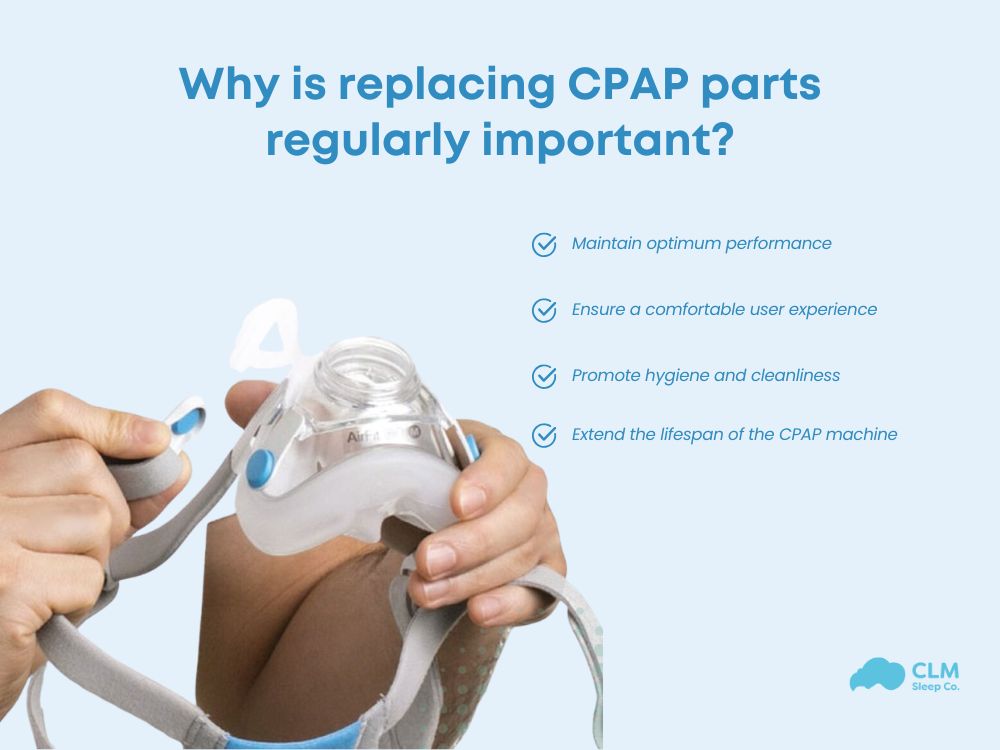
Key CPAP parts and their replacement frequency
Understanding the lifespan of each component helps maintain high therapy standards. Below is a comprehensive guide to each part’s recommended replacement timeline, rationale, and warning signs.
Mask (Nasal, Pillow, or Full-Face)
- How often to replace CPAP parts: Every 6 months.
- Why: The seal of the mask weakens over time, causing air leaks and reduced comfort.
- Signs: You need a new one: Air leaks, facial discomfort, cracks, or hardening of materials.
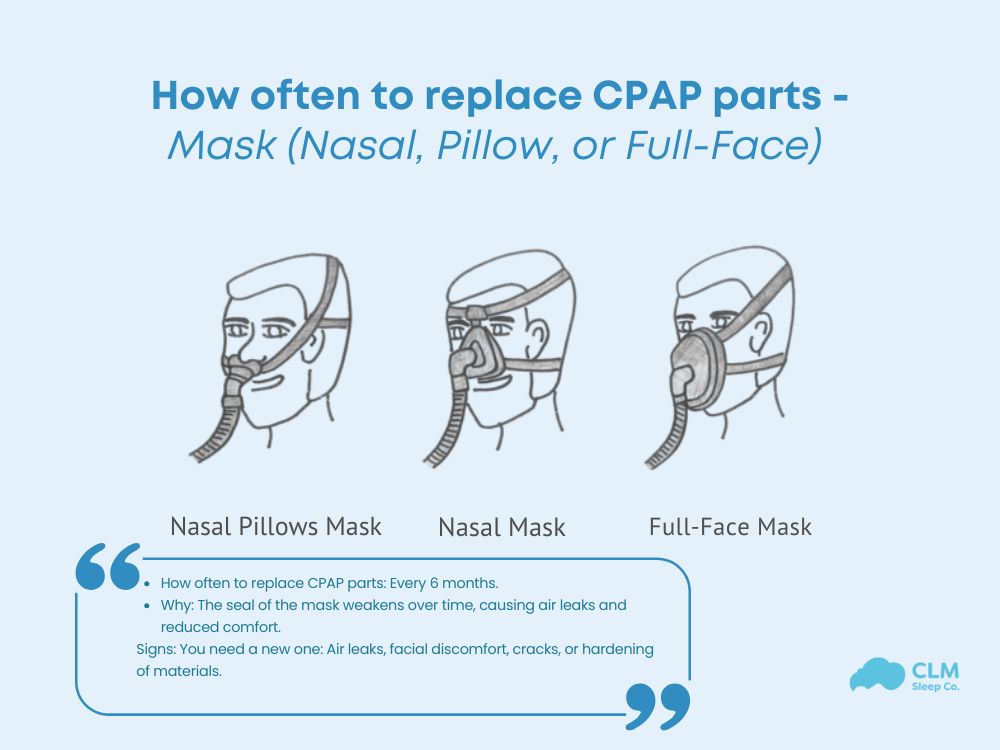
Mask Cushions
Silicone Cushions
- How often to replace: Every 2–4 weeks
- Why: Silicone breaks down rapidly with exposure to facial oils and daily cleaning.
- Signs: Poor seal, visible discoloration, or cracks in the material.
Memory Foam Cushions
- How often to replace: Every 30 days
- Why: It absorbs moisture and loses form faster than silicone.
- Signs: Flaking, poor fit, or visible deterioration.
Headgear
- How often to replace: Every 6 months
- Why: Elastic loses tension over time, causing mask slippage and discomfort.
- Signs: Loose fit, slippage, or fraying fabric.

Frame
- How often to replace: Every 3–6 months
- Why: The mask frame may warp or crack with repeated use and cleaning.
- Signs: Poor stability, cracks, or inability to secure the mask properly.
Short Mask Tubes
- How often to replace: Every 3 months
- Why: These tubes are prone to hardening and cracking with frequent use.
- Signs: Audible air leaks, stiff tubing, or visible damage.
Standard or Heated Long Tubes
- How often to replace: Every 3–6 months
- Why: Long hoses can harbor mold, lose flexibility, or develop internal blockages.
- Signs: Musty smell, visible mold, airflow obstruction, or kinks.
Air Filters
Disposable Filters
- How often to replace: Every 2–4 weeks
- Why: Traps dust and allergens, but can clog quickly.
- Signs: Reduced airflow, visible dirt, or sneezing while using the device.
Reusable Filters
- How often to replace: Every 6 months (with regular cleaning)
- Why: More durable, but eventually wears out.
- Signs: Warping, loss of filtration efficiency, or visible tearing.
Humidifier Chamber
- How often to replace: Every 6 months
- Why: Mineral deposits from water and mold growth can occur.
- Signs: Cloudy appearance, cracks, or residue buildup.
Additional tips for maintaining CPAP equipment
In addition to replacing CPAP parts on schedule, proper daily and weekly maintenance plays a vital role in ensuring your device remains effective and hygienic. Taking just a few minutes each week to clean and inspect your equipment can prevent performance issues, reduce health risks, and extend the life of your CPAP machine. Here are some practical tips to help you care for your CPAP gear more efficiently:
- Routine cleaning: Once a week, disassemble your mask, tubing, and humidifier water chamber. Wash each part with warm water and a mild, fragrance-free detergent. Avoid using harsh chemicals like bleach, vinegar, or alcohol-based cleaners, as these can degrade the materials and cause irritation when inhaled.
- Dry completely: After cleaning, ensure all components are completely dry before reassembling. Lay the parts on a clean, dry towel in a well-ventilated area and allow them to air dry naturally. Moisture left in the system can promote mold and bacteria growth.
- Leak checks: Regularly examine your mask and tubing for signs of wear or damage, such as small holes or cracks. Also, check the mask fit during use—air leaks can reduce therapy effectiveness and cause discomfort or noise.
- Avoid sunlight: Store your CPAP machine and accessories in a cool, dry location, away from direct sunlight or extreme temperatures. Heat and UV exposure can degrade plastic and silicone materials, shortening the life of your equipment.
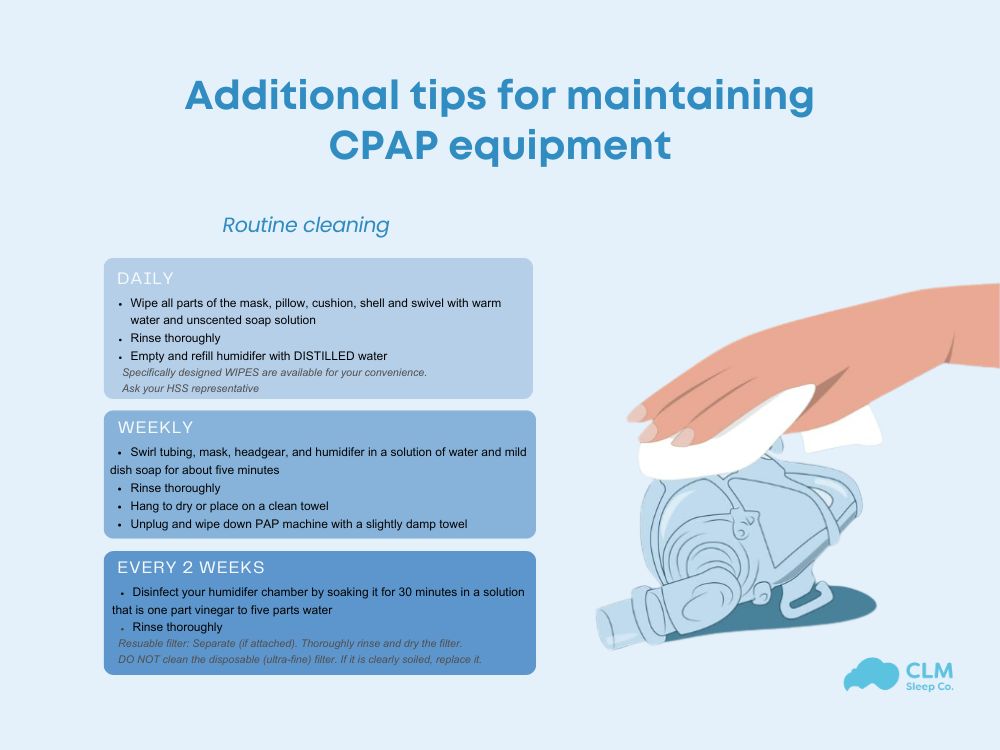
How to order replacement CPAP Parts in Australia?
Over time, CPAP components naturally wear out and need to be replaced to maintain the effectiveness and hygiene of your sleep therapy. Whether you need a new mask cushion, tubing, filters, or a humidifier chamber, knowing where and how to order replacement parts can make the process easier and help you avoid unnecessary delays in your treatment. Below is a detailed guide to help you order CPAP replacement parts safely and efficiently in Australia.
Where to Buy
Always purchase CPAP replacement parts from licensed Australian medical suppliers or accredited sleep therapy clinics. These authorized vendors, such as CLM Sleep, offer genuine products that meet Australian health standards. They often provide customer support, product guidance, and troubleshooting assistance to help ensure you choose the right components for your device. Avoid ordering from unverified online marketplaces, as counterfeit or incompatible parts can pose safety risks and reduce your therapy’s effectiveness.
What to Look For
When selecting replacement parts, choose products from reputable manufacturers such as ResMed, Philips Respironics, or Fisher & Paykel—brands known for their quality and compatibility with a wide range of CPAP devices.
To ensure a proper fit:
- Check your CPAP machine’s model number (usually found on the back or bottom of the device).
- Compare part numbers or product codes before purchasing.
- Consult your supplier or sleep clinic if you’re unsure which part is compatible with your setup.
Many suppliers also provide compatibility guides online or offer phone/email support to confirm whether a part matches your specific model.
Warranty and Returns
Before finalizing your purchase, review the seller’s warranty and return policies:
- Reputable suppliers typically offer refunds or exchanges for defective or incorrect items.
- Keep a copy of your invoice or order confirmation in case you need to file a warranty claim later.
- Some products, such as masks or humidifier chambers, may have limited warranties based on the manufacturer’s guidelines.
Reading the fine print can help you avoid complications and give you peace of mind when replacing essential CPAP components.
Conclusion
Sticking to a regular CPAP replacement schedule is crucial for effective, safe, and comfortable sleep apnea treatment. Each part has a unique lifespan and specific signs of wear that users should watch for. By investing in timely replacements and sourcing from trusted Australian providers, you ensure that your therapy remains hygienic, effective, and hassle-free. Better maintenance leads to better sleep and better health.
